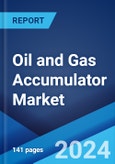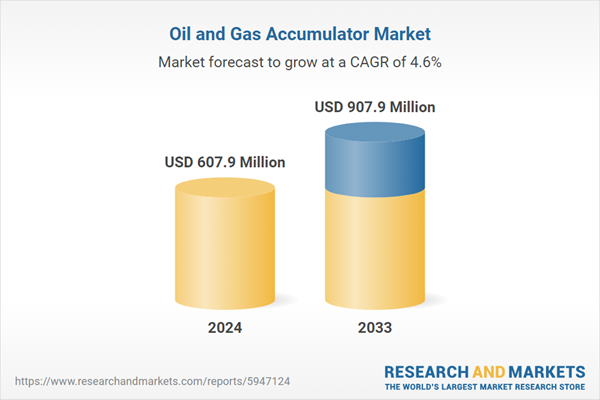The global oil and gas accumulator market size reached USD 607.9 Million in 2024. Looking forward, the publisher expects the market to reach USD 907.9 Million by 2033, exhibiting a growth rate (CAGR) of 4.33% during 2025-2033. The increasing exploration and production (E&P) activities across the globe, the implementation of stringent safety and regulatory measures, and the escalating demand for energy efficient solutions represent some of the key factors driving the market.
An oil and gas accumulator is a device used in the oil and gas industry to store hydraulic energy in the form of pressurized fluid. It is a critical component of hydraulic systems in various applications, ranging from drilling operations and well control systems to offshore platforms and production equipment. The primary purpose of an accumulator is to store hydraulic energy under pressure and release it as needed to perform specific functions. It consists of a pressure vessel or cylinder, a piston or bladder separating the hydraulic fluid from a gas or nitrogen charge, and necessary valves and fittings. They help regulate system pressure, dampen pressure fluctuations, and compensate for changes in fluid volume, ensuring stable and consistent performance. Moreover, by storing excess energy and releasing it when required, accumulators enhance the efficiency of hydraulic systems, reduce power consumption and minimize energy waste. Owing to these properties, these accumulators are widely utilized in drilling rigs, offshore platforms, well control systems, production equipment, and other hydraulic applications throughout the oil and gas industry.
An oil and gas accumulator is a device used in the oil and gas industry to store hydraulic energy in the form of pressurized fluid. It is a critical component of hydraulic systems in various applications, ranging from drilling operations and well control systems to offshore platforms and production equipment. The primary purpose of an accumulator is to store hydraulic energy under pressure and release it as needed to perform specific functions. It consists of a pressure vessel or cylinder, a piston or bladder separating the hydraulic fluid from a gas or nitrogen charge, and necessary valves and fittings. They help regulate system pressure, dampen pressure fluctuations, and compensate for changes in fluid volume, ensuring stable and consistent performance. Moreover, by storing excess energy and releasing it when required, accumulators enhance the efficiency of hydraulic systems, reduce power consumption and minimize energy waste. Owing to these properties, these accumulators are widely utilized in drilling rigs, offshore platforms, well control systems, production equipment, and other hydraulic applications throughout the oil and gas industry.
Oil and Gas Accumulator Market Trends:
The market is primarily driven by the increasing exploration and production (E&P) activities. Oil and gas accumulators play a crucial role in these operations by providing hydraulic energy storage solutions in wellhead control systems and blowout preventers. In addition, the surging need to comply with safety regulations represents another major growth-inducing factor. Accumulators are utilized in critical safety systems, such as emergency shutdown systems, to ensure the safe and reliable operation of various equipment and processes. Therefore, stringent safety regulations and the focus on preventing accidents and spills are contributing to market growth. Besides this, the market is also propelled by the escalating demand for energy-efficient solutions. Accumulators help optimize energy usage by storing and releasing hydraulic energy as needed, improving the overall efficiency of hydraulic systems. Moreover, technological advancements in the design, materials, and manufacturing processes of oil and gas accumulators have improved their performance and reliability. These advancements result in the replacement of older units and encourage the adoption of newer, more advanced accumulator systems. This, coupled with the increasing investments by governments of numerous countries in power generation, maximizing oil and gas production, and other end use sectors, is positively influencing the market growth.Key Market Segmentation:
The publisher provides an analysis of the key trends in each segment of the global oil and gas accumulator market, along with forecasts at the global, regional, and country levels from 2025-2033. Our report has categorized the market based on type, deployment location, and application.Type Insights:
- Bladder Accumulator
- Piston Accumulator
- Diaphragm Accumulator
Deployment Location Insights:
- Offshore
- Onshore
Application Insights:
- Blow-out Preventor
- Drilling Rigs
- Mud Pumps
Regional Insights:
- North America
- United States
- Canada
- Europe
- Germany
- France
- United Kingdom
- Italy
- Spain
- Russia
- Others
- Asia Pacific
- China
- Japan
- India
- South Korea
- Australia
- Indonesia
- Others
- Latin America
- Brazil
- Mexico
- Others
- Middle East and Africa
Competitive Landscape:
The report has also provided a comprehensive analysis of the competitive landscape in the global oil and gas accumulator market. Detailed profiles of all major companies have also been provided. Some of the companies covered include Accumulator Inc., Airmo Inc., Bosch Rexroth AG (Robert Bosch GmbH), Eaton Corporation PLC, Freudenberg & Co. KG, HAWE Hydraulik SE, Hydac Verwaltung GmbH, Hydroll, Nippon Accumulator Co. Ltd., NOK Corporation, Parker-Hannifin Corporation, Rotec Hydraulics Ltd., Roth Industries LLC (Roth Industries GmbH & Co. KG), etc. Kindly note that this only represents a partial list of companies, and the complete list has been provided in the report.Key Questions Answered in This Report:
- How has the global oil and gas accumulator market performed so far, and how will it perform in the coming years ?
- What are the drivers, restraints, and opportunities in the global oil and gas accumulator market ?
- What is the impact of each driver, restraint, and opportunity on the global oil and gas accumulator market ?
- What are the key regional markets ?
- Which countries represent the most attractive oil and gas accumulator market ?
- What is the breakup of the market based on the type ?
- Which is the most attractive type in the oil and gas accumulator market ?
- What is the breakup of the market based on the deployment location ?
- Which is the most attractive deployment location in the oil and gas accumulator market ?
- What is the breakup of the market based on application ?
- Which is the most attractive application in the oil and gas accumulator market ?
- What is the competitive structure of the global oil and gas accumulator market ?
- Who are the key players/companies in the global oil and gas accumulator market ?
Table of Contents
1 Preface3 Executive Summary11 Value Chain Analysis13 Price Analysis
2 Scope and Methodology
4 Introduction
5 Global Oil and Gas Accumulator Market
6 Market Breakup by Type
7 Market Breakup by Deployment Location
8 Market Breakup by Application
9 Market Breakup by Region
10 Drivers, Restraints, and Opportunities
12 Porters Five Forces Analysis
14 Competitive Landscape
List of Figures
List of Tables
Companies Mentioned
- Accumulator Inc.
- Airmo Inc.
- Bosch Rexroth AG (Robert Bosch GmbH)
- Eaton Corporation PLC
- Freudenberg & Co. KG
- HAWE Hydraulik SE
- Hydac Verwaltung GmbH
- Hydroll
- Nippon Accumulator Co. Ltd.
- NOK Corporation
- Parker-Hannifin Corporation
- Rotec Hydraulics Ltd.
- Roth Industries LLC (Roth Industries GmbH & Co. KG)
Methodology

LOADING...
Table Information
| Report Attribute | Details |
|---|---|
| No. of Pages | 141 |
| Published | March 2025 |
| Forecast Period | 2024 - 2033 |
| Estimated Market Value ( USD | $ 607.9 Million |
| Forecasted Market Value ( USD | $ 907.9 Million |
| Compound Annual Growth Rate | 4.6% |
| Regions Covered | Global |
| No. of Companies Mentioned | 13 |









